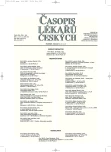Antithrombotic therapy after heart valve surgery – current evidence and future trends
Authors:
Miroslava Benešová
Authors‘ workplace:
Kardiochirurgické oddělení Nemocnice Na Homolce, Praha
Published in:
Čas. Lék. čes. 2011; 150: 229-235
Category:
Review Article
Overview
Degenerative valve disease is a growing problem because of the rising amount of degenerative heart valve disease and valve replacement operations among the elderly. More than 300,000 prosthetic heart valve replacements are performed each year worldwide and this rate is projected to increase to as many as 850,000 per year by 2050. There is a higher risk of thomboembolic events following heart valve surgery; and anticoagulation and antiplatelet therapies are necessary. The drug therapy selection depends on the type of surgery performed and the individual risk of the patient in any given situation. This article review assesses the benefit and risks of various therapy schemes as recommended by the Czech, European and American Associations of Cardiologists and Cardiosurgeons.
Key words:
mechanical heart valve prosthesis, bioprosthesis, plastic valves, anticoagulation, antiagregation, warfarin, unfractionated heparin, low molecular weight heparin, aspirin, embolism, thrombosis.
Sources
1. Sun JCJ, Davidson MJ, Lamy A, et al. Antitrombotic management of patiens with prosthetic heart valves: current evidence and future trends. Lancet 2009; 374 : 565–576.
2. Popelová J, Benešová M, Brtko M, et al. Doporučené postupy pro diagnostiku a léčbu chlopenních srdečních vad v dospělosti. Cor Vasa 2007; 49(7–8): Kardio.
3. The Task Force on the Management of Valvular Heart Disease of the European Society of Cardiology. Guidelines on the management of valvular heart disease. Eur Heart J 2007; 28 : 230–268.
4. American College of Cardiology. American Heart Association Task Force on Practice Guidelines. ACC. AHA 2006 guielines for the management of patiens with valvular heart disease. J Am Coll Cardiol 2006; 48: e1–148.
5. Dunning J, Versteegh M, Fabbri A, et al. Guideline on antiplatelet and anticoagulation management in cardiac Sumery. Eur J Cardiothorac Surg 2008; 34 : 73–92.
6. Salem DN, Stein PD, Al-Ahmad A, et al. Antithrombotic Therapy in Valvular Heart Disease – Native and Prosthetic. Chest 2004; 126 : 457S–482S.
7. Butchart EG. Antithrombotic management in patiens with prosthetic valves: a comparison of American and European Guidelines. Heart 2009; 95 : 430–136.
8. Sundt TM, Zehr KJ, Dearani JA, et al. Is early anticoagulation with warfarin necessary after bioprosthetic aortic valve replacement? J Thorac Cardiovasc Surg 2005; 129 : 1024–31.
9. Colli A, et al. ACTION registry survey results, Eur J Cardiothorac Surg 2008; 33 : 531–536.
10. Laplace G, Lafitte S, LabŹque JN, et al. Clinical Signicance of Early Thrombosis After Prosthetic Mitral Valve Replacement. J Am Coll Cardiol 2004; 43 : 1283–1290.
11. Henneghan C, et al. A useful meta-analysis of the many trials of anticoagulation self monitoring with discussion of benefits and limitation in practice. Lancet 2006; 367 : 404–411.
12. Butchart EG, Gohlke-Bärwolf Ch, Antunes MJ, et al. Recommendations for the management of patiens after heart valve Sumery. Eur Heart J 2005; 26 : 2463–2471.
13. Chan WS, Anand S, Ginsberg JS. Anticoagulation of pregnant women with mechanical heart valves: a systematic review of the literature. Arch Intern Med 2000; 160 : 191–196.
14. Oakley C, Child A, Iung B, et al. Expert konsensus document on management of cardiovascular dinase during pregnancy. The task force on management of cardiovascular disease during pregnancy of the European Society of Cardiology. Eur Heart J 2003; 24 : 761–768.
15. Elkayam U. Valvular heart disease and pregnancy.Part II: Prosthetic valves. J Am Coll Cardiol 2005; 46 : 403–410.
16. Barbour LA, Oja JL, Schultz LK. A prospective trial that demonstrates that dalteparin requirements increase in pregnancy to maintain therapeutic levels of anticoagulation. American Journal of Obstetrics and Gynecology 2004; 3 : 1024–1029.
17. Herijgers P, Verhamme P. Improving the quality of antikoagulant in patiens with mechanical heart valves: what are we waiting for? EHJ 2007; 28 : 2424–2426.
Labels
Addictology Allergology and clinical immunology Angiology Audiology Clinical biochemistry Dermatology & STDs Paediatric gastroenterology Paediatric surgery Paediatric cardiology Paediatric neurology Paediatric ENT Paediatric psychiatry Paediatric rheumatology Diabetology Pharmacy Vascular surgery Pain management Dental HygienistArticle was published in
Journal of Czech Physicians

- Advances in the Treatment of Myasthenia Gravis on the Horizon
- Metamizole in perioperative treatment in children under 14 years – results of a questionnaire survey from practice
- Metamizole vs. Tramadol in Postoperative Analgesia
- What Effect Can Be Expected from Limosilactobacillus reuteri in Mucositis and Peri-Implantitis?
- The Importance of Limosilactobacillus reuteri in Administration to Diabetics with Gingivitis
Most read in this issue
- Early repolarisation syndrome and idiopathic ventricular fibrillation
- Temporal lobe epilepsy in adults and possibilities of neurosurgical treatment: the role of magnetic resonance
- Nonconvulsive status epilepticus
- Measurement of exhaled nitric oxide in the diagnosis of asthma
